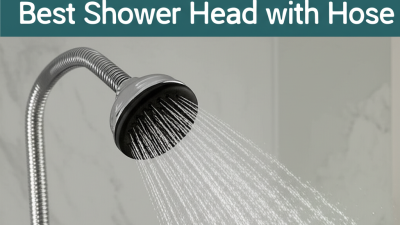
How to Choose the Perfect Bathroom Shower Hose for Your Home: Tips and Recommendations
When it comes to bathroom renovations, selecting the right fixtures is crucial for achieving both functionality and style. The bathroom shower hose is a key component often overlooked in the home improvement process. According to a report by the National Kitchen and Bath Association, nearly 83% of homeowners consider the shower experience a vital aspect of their daily routine, underlining the importance of choosing a high-quality shower hose. With various options available in terms of length, material, and design, making an informed decision can significantly enhance your shower experience. Additionally, studies show that a well-chosen bathroom shower hose can improve water efficiency and pressure, contributing to a more eco-friendly home. This guide will explore essential tips and recommendations to help you select the perfect bathroom shower hose that fits your needs and complements your overall bathroom design.

Understanding Different Types of Shower Hoses: Material and Design Options
When choosing the perfect bathroom shower hose, understanding the various types of materials and designs is crucial for enhancing both functionality and aesthetics. Shower hoses are commonly made from materials such as stainless steel, plastic, and reinforced rubber. Stainless steel hoses are known for their durability and resistance to kinks and tangles, making them an excellent choice for long-term use. On the other hand, plastic hoses are lightweight and economical, although they may not last as long as metal options. Reinforced rubber hoses offer a balance between flexibility and durability, suitable for those seeking both comfort and robustness.
In addition to materials, the design of the shower hose can significantly impact your shower experience. Many modern hoses feature flexible and swivel ends that allow for easy maneuverability, preventing twisting during use. A longer hose can provide greater reach, perfect for larger showers or for those who prefer additional mobility while showering. Furthermore, various finishes and colors are available, enabling homeowners to match their shower hoses with their bathroom decor. This combination of functionality and style is vital for creating a relaxing and enjoyable bathing environment.
Key Factors to Consider When Choosing a Shower Hose for Your Bathroom
When selecting the perfect bathroom shower hose, several key factors must be considered to ensure functionality and durability. First and foremost, the material of the shower hose plays a crucial role in its longevity and resistance to wear and tear. According to a report by the Home Improvement Research Institute, stainless steel hoses are recommended for their excellent corrosion resistance and strength, making them an ideal choice for various water qualities. Additionally, flexible materials such as reinforced vinyl can provide ease of use, especially in tight bathroom spaces.
Another critical aspect to consider is the length and diameter of the hose. Standard shower hoses typically range from 59 inches to 79 inches, but choosing the right length is essential for accessibility and comfort. A study published in the Journal of Plumbing Research highlights that hoses with a diameter of 1/2 inch not only enhance water flow but also reduce pressure loss, providing a more enjoyable showering experience. Furthermore, compatibility with your existing showerhead and ease of installation are vital factors that can significantly influence your final decision. By prioritizing these considerations, homeowners can choose a shower hose that meets their needs and complements their bathroom decor.
Shower Hose Length Preferences
Benefits of Flexible vs. Rigid Shower Hoses: Which is Right for You?
When selecting a shower hose for your bathroom, the choice between flexible and rigid options is crucial, as each serves unique purposes. Flexible shower hoses are particularly beneficial for those who value versatility and ease of use. They bend and stretch, allowing for a greater range of movement and making it easier to rinse hard-to-reach areas. This flexibility is great for families or individuals with varying heights, as it accommodates different showering positions comfortably.
On the other hand, rigid hoses offer a certain aesthetic appeal and durability that can enhance the overall look of your bathroom. They often come with higher resistance to kinks and bends, ensuring a steady flow of water. However, they might limit movement compared to their flexible counterparts.
**Tips for Choosing a Shower Hose:**
1. Consider the size and configuration of your shower space to determine how much flexibility you’ll need.
2. Look for hoses made from high-quality materials that prevent kinking while being lightweight and easy to handle.
3. Think about your showering habits; if you frequently adjust the angle of the shower head, a flexible hose may be the better choice, while a more fixed setup may benefit from a rigid hose.
How to Choose the Perfect Bathroom Shower Hose for Your Home: Tips and Recommendations - Benefits of Flexible vs. Rigid Shower Hoses: Which is Right for You?
| Feature | Flexible Hose | Rigid Hose |
|---|---|---|
| Ease of Use | Highly flexible, easier to maneuver. | Less maneuverable but stable. |
| Installation | Usually straightforward and lightweight. | May require specific fittings. |
| Durability | Good but can be prone to kinks. | Very durable and resistant to damage. |
| Maintenance | Easy to clean; may need periodic checking. | Low maintenance; less susceptible to mineral build-up. |
| Cost | Typically more affordable. | Often higher upfront cost. |
| Aesthetics | Various styles and colors available. | Stylish and modern design options. |
How to Measure Your Bathroom Space for the Ideal Shower Hose Length
When selecting the perfect bathroom shower hose, measuring your space accurately is crucial to ensure the ideal length. Start by determining the distance from your showerhead to the floor or where you prefer the hose to hang. A common length for shower hoses ranges from 59 to 79 inches, but measuring your specific space will guarantee a comfortable fit and usability.
Tips for measuring your bathroom space include using a flexible measuring tape and ensuring you account for any obstructions such as shelves or bathroom fixtures. If you plan to install a handheld showerhead, consider how high you want the showerhead mounted to find a suitable hose length that allows for easy maneuverability. This additional length will also accommodate varying user heights and preferences, ensuring a versatile setup for all family members.
Moreover, remember that the hose should have enough slack without being too long to avoid tangling or damage. A well-measured shower hose will not only enhance the aesthetics of your bathroom but will also improve your showering experience significantly. Aim for a balance that offers flexibility and convenience without compromising on style.
Tips for Installation and Maintenance of Your Shower Hose for Longevity
When it comes to installing a shower hose, proper technique is crucial for ensuring longevity and functionality. According to the Home Improvement Research Institute, nearly 60% of shower-related issues arise from improper installations. To avoid leaks and future problems, ensure that the hose is securely connected to both the faucet and the shower head. Always use plumber's tape on threaded areas to create a watertight seal, and check for any kinks or twists in the hose during installation that could lead to wear and tear over time.
Regular maintenance is equally important in prolonging the life of your shower hose. A study by the International Journal of Plumbing and Heating found that hoses exposed to excessive heat or corrosive cleaning chemicals can degrade 30% faster than those maintained under optimal conditions. To maintain your shower hose, clean it regularly with mild soap and water, avoiding harsh chemicals. Additionally, inspect the hose periodically for any signs of wear, such as cracks or fraying, and replace it if necessary. Implementing these simple maintenance tips can significantly extend the lifespan and performance of your shower hose, making your bathroom experience both enjoyable and efficient.
Related Posts
-

Innovative Technologies Shaping the Future of Best Shower Hoses by 2025 with Essential Industry Checklist
-

How to Choose the Right Shower Hose for Optimal Water Pressure and Performance
-

What is a Shower Hose and How Does It Enhance Your Bathroom Experience?
-

7 Essential Features of the Best Shower Head With Hose for Ultimate Comfort and Style
-

Ultimate Checklist: Top 5 Features to Look for in the Best Shower Head with Hose
-

Ultimate Kitchen Shower Hose Checklist: Ensure You Choose the Perfect Fit for Your Home



